With over 100 VFX industrial light, Harrison Ford de-aged for 'Indiana Jones 5'
By IANS | Published: July 8, 2023 11:38 AM2023-07-08T11:38:14+5:302023-07-08T11:40:06+5:30
Los Angeles, July 8 Hollywood star Harrison Ford, 80, was de-aged using several filmmaking techniques for his part ...

With over 100 VFX industrial light, Harrison Ford de-aged for 'Indiana Jones 5'
Los Angeles, July 8 Hollywood star Harrison Ford, 80, was de-aged using several filmmaking techniques for his part in 'Indiana Jones and the Dial of Destiny'. Ford plays the whip-cracking archaeologist in the film.
The shots of a young Ford look impressive, and it's thanks to the team of over 100 artists at Industrial Light and Magic, who spent three years on the film's visual effects, which also included enhancing and developing their existing de-aging technology to create ILM FaceSwap, reports Variety.
Photorealism de-aging was nothing new to the team. After all, technology such as Flux existed and had been used on films such as 'Ant-Man and the Wasp: Quantumania' and 'The Irishman'. But when Whitehurst and Robert Weaver, VFX supervisor at ILM, first took on the James Mangold-helmed 'Dial of Destiny', they knew this was going to be the biggest project they had undertaken.
"We knew we would have to use all of the tools we already had and develop some new ones," Whitehurst said. So they developed ILM FaceSwap.
As per Variety, this new set of tools allowed the team to blend a full computer-generated 3D head, combine elements that had been extracted from on-set photography and, as Whitehurst explains, use "machine learning-based reference material from previous 'Indiana Jones' films."
Once the artists had that reference material, including a raw clay model in the shape of Ford’s Indy, they went to work making the actor look like a younger version of himself on a shot-by-shot basis.
Weaver explains that while the machine learning aspect gave them a 2D replica of what they needed, there was still a full 3D CG asset that needed to be built.
"That involved putting Harrison through the process of recording all the facial performances and all its extremes, and the marrying of various technologies by the artists to blend between one and the other to get the final performance that you're looking for," Weaver explained.
"The important aspect is that there’s not a single recipe that was cooked up that could be done for all shots."
Whitehurst worked on the film for over three years, and one of the first things he did was "scan Harrison's head so we had a current cast."
Once they had that, he and his team began building the 1944 CG head and used other elements from the Lucasfilm archives to help build that out.
While they were doing that, they also storyboarded the film's prologue sequence to get an idea of the shots they needed.
--IANS
Disclaimer: This post has been auto-published from an agency feed without any modifications to the text and has not been reviewed by an editor
Open in app